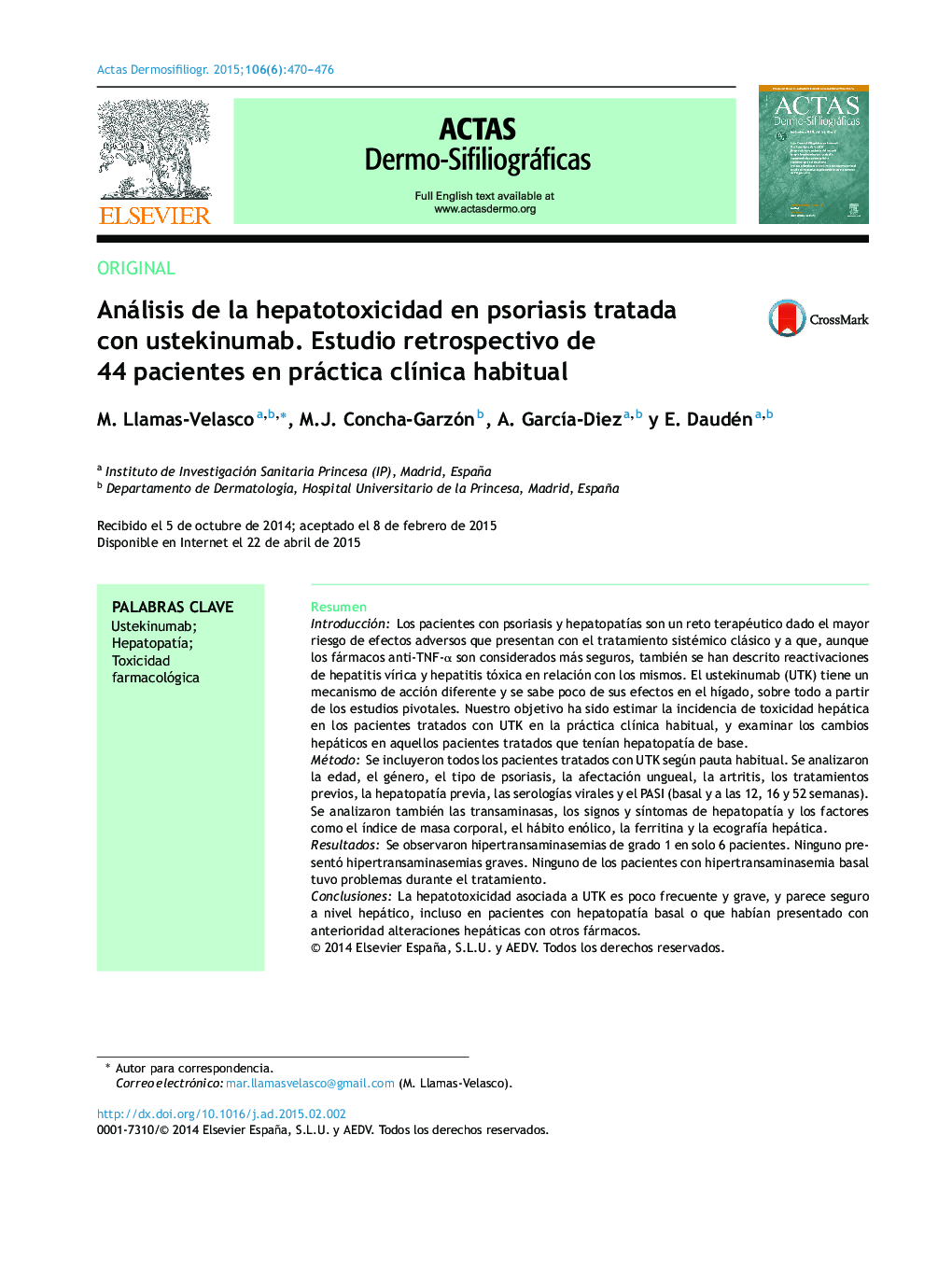| کد مقاله | کد نشریه | سال انتشار | مقاله انگلیسی | نسخه تمام متن |
|---|---|---|---|---|
| 3179833 | 1200479 | 2015 | 7 صفحه PDF | دانلود رایگان |
ResumenIntroducciónLos pacientes con psoriasis y hepatopatías son un reto terapéutico dado el mayor riesgo de efectos adversos que presentan con el tratamiento sistémico clásico y a que, aunque los fármacos anti-TNF-α son considerados más seguros, también se han descrito reactivaciones de hepatitis vírica y hepatitis tóxica en relación con los mismos. El ustekinumab (UTK) tiene un mecanismo de acción diferente y se sabe poco de sus efectos en el hígado, sobre todo a partir de los estudios pivotales. Nuestro objetivo ha sido estimar la incidencia de toxicidad hepática en los pacientes tratados con UTK en la práctica clínica habitual, y examinar los cambios hepáticos en aquellos pacientes tratados que tenían hepatopatía de base.MétodoSe incluyeron todos los pacientes tratados con UTK según pauta habitual. Se analizaron la edad, el género, el tipo de psoriasis, la afectación ungueal, la artritis, los tratamientos previos, la hepatopatía previa, las serologías virales y el PASI (basal y a las 12, 16 y 52 semanas). Se analizaron también las transaminasas, los signos y síntomas de hepatopatía y los factores como el índice de masa corporal, el hábito enólico, la ferritina y la ecografía hepática.ResultadosSe observaron hipertransaminasemias de grado 1 en solo 6 pacientes. Ninguno presentó hipertransaminasemias graves. Ninguno de los pacientes con hipertransaminasemia basal tuvo problemas durante el tratamiento.ConclusionesLa hepatotoxicidad asociada a UTK es poco frecuente y grave, y parece seguro a nivel hepático, incluso en pacientes con hepatopatía basal o que habían presentado con anterioridad alteraciones hepáticas con otros fármacos.
IntroductionThe therapy of patients with psoriasis and liver disease can be a challenge due to the increased risk of adverse effects from traditional systemic treatments; in addition, although the anti-tumor necrosis factor agents are considered safer, they have also been associated with drug-induced liver injury and reactivation of viral hepatitis. Ustekinumab has a different mechanism of action and the little that is known of its effects on the liver comes from pivotal studies. The objectives of this study were to estimate the incidence of drug-induced liver injury in patients treated with ustekinumab in daily clinical practice and to analyze liver alterations in those patients with pre-existing liver disease.MethodAll patients treated with the standard regimen of ustekinumab were included in the study. Variables gathered included age, sex, type of psoriasis, nail involvement, arthritis, previous treatments, history of liver disease, viral serology, Psoriasis Area Severity Index (at baseline and at 12, 16, and 52 weeks), transaminase levels, manifestations of liver disease, liver ultrasound, and factors such as body mass index, alcohol consumption, and ferritin levels.ResultsGrade 1 elevation of the transaminases was only observed in 6 patients; no cases of severe hypertransaminasemia were observed. None of the patients with elevation of the transaminases at baseline developed problems during treatment.ConclusionsUstekinumab-related liver injury is uncommon and mild. From a hepatic point of view, the drug appears safe, even in patients with pre-existing liver disease and those who have developed altered liver function previously with other drugs.
Journal: Actas Dermo-Sifiliográficas - Volume 106, Issue 6, July–August 2015, Pages 470–476
